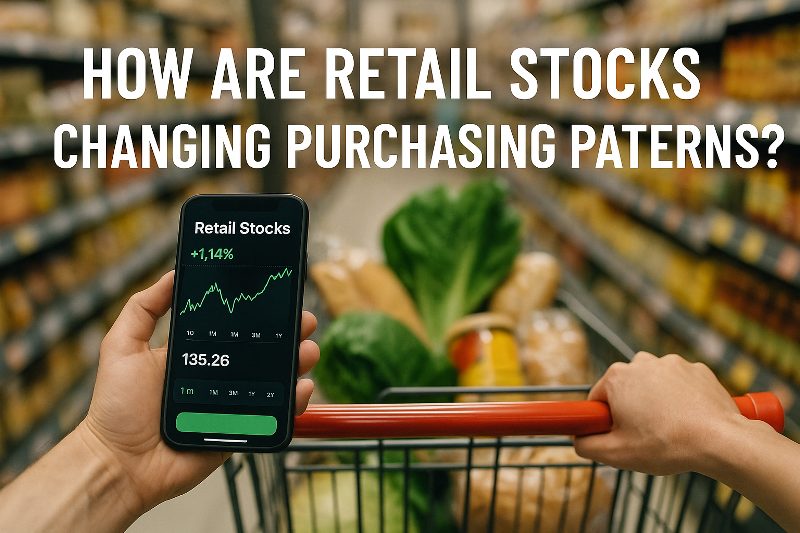How are Retail Stocks Changing Purchasing Patterns?
Retail stocks reflect how people shop, save, and spend. When companies like Reliance Retail, DMart, and Big Bazaar adjust their inventory or pricing strategies, consumers often respond by changing what, when, and how they buy.
In today’s fast-paced market, where supply chains and inflation are constantly shifting, understanding this connection is more important than ever. This article covers how retail stock patterns affect consumer buying habits by analyzing economic conditions, seasonal patterns, and technological advancements.
The Influence of Retail Stock Levels on Consumer Behavior
Retail stock levels significantly influence consumer behavior. When popular items are unavailable, customers may switch brands, delay purchases, or shop elsewhere, leading to lost sales and diminished loyalty.
On the other hand, limited stock can create urgency, prompting impulse buys—a tactic known as “hunger marketing.”
For instance, Avenue Supermarts (DMart) has experienced shifts in consumer purchasing patterns due to stock availability. Notably, the Avenue Supermarts share price dropped over 9% after Q2 FY25 earnings missed expectations, partly due to competition from quick commerce platforms offering rapid delivery and consistent stock availability.
This scenario underscores the importance of effective inventory management in retaining customer trust and maintaining market competitiveness.
Economic Factors Affecting Retail Stocks
Economic factors like tariffs and inflation are other factors that influence retail stock levels and consumer purchasing patterns. In April 2025, the U.S. imposes steep tariffs—up to 145% on Chinese imports and 25% on goods from Canada and Mexico. This led to immediate price hikes on everyday items like electronics, toys, and clothing.
Retailers passed these costs to consumers, prompting many to rush purchases before further increases. For example, March retail sales rose 1.4% as shoppers bought big-ticket items ahead of the tariffs.
However, this surge was short-lived; consumer confidence dropped, and spending slowed as prices continued to climb. The changing economic conditions have led retailers to modify their inventory management and pricing approaches.
In India, similar economic pressures have impacted retail chains like Vishal Mega Mart. The Vishal Mega Mart share price experienced fluctuations in response to these global economic shifts. After its IPO in December 2024, where shares were listed at ₹104—a 33% premium over the IPO price of ₹78 —the stock saw varied performance.
By May 2025, the share price stood at ₹120+, reflecting market volatility amid economic uncertainties.
Seasonal Trends and Their Impact
The retail industry increases its inventory of popular items during Diwali and Christmas, while consumers tend to spend more on gifts and celebratory products.
On the other hand, retailers increase discounts during post-holiday seasons to clear their excess inventory, which attracts customers who seek bargains. Also, weather changes impact buying behaviors; for instance, colder months may boost sales of warm clothing and heating appliances.
Retailers leverage these predictable patterns to optimize inventory and tailor marketing strategies, ensuring they meet consumer demand effectively throughout the year.
Technological Advancements in Inventory Management
Technological advancements have revolutionized inventory management, enabling retailers to monitor stock levels in real-time and predict future demand accurately.
Technologies such as Radio Frequency Identification (RFID) tags, Internet of Things (IoT) devices, and artificial intelligence (AI) facilitate real-time tracking of inventory, reducing the risk of stockouts and overstocking. For instance, RFID tags allow businesses to monitor inventory levels, locations, and movements with unprecedented precision.
A notable example is Amazon, which employs predictive analytics to forecast demand, optimize stocking levels, and enhance overall supply chain efficiency.
By analyzing vast amounts of data in real time, Amazon can make accurate predictions about which products will be in high demand in specific regions and at particular times. This proactive approach helps minimize stockouts, reduce overstock situations, and improve order fulfillment speed.
Conclusion
Retail stock levels play a crucial role in shaping consumer purchasing patterns. When products are scarce, shoppers often act quickly to secure items, sometimes choosing different brands or stores. Economic factors like inflation and trade policies influence what people buy and how much they spend. Seasonal trends and technological advancements in inventory management also affect shopping behaviors. Understanding these dynamics helps retailers meet customer needs and adapt to changing market conditions.







